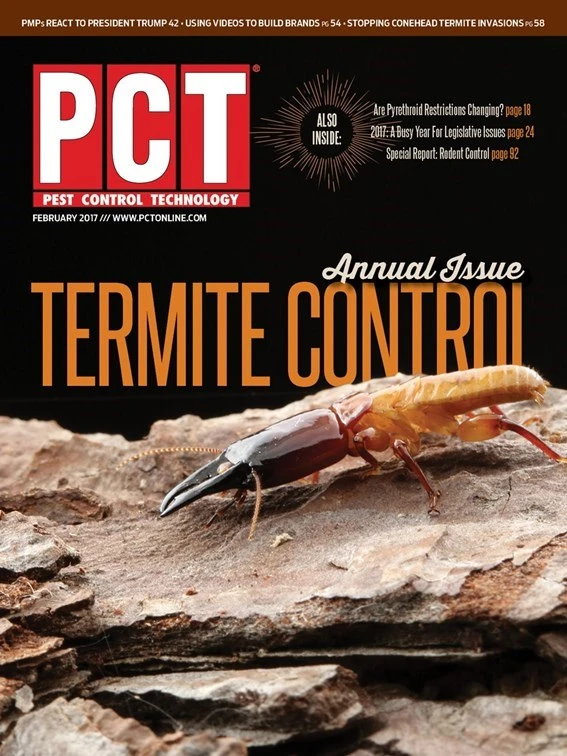
Classic television aficionados will remember the zany 1970s Saturday Night Live skit with Dan Aykroyd, Jane Curtin and Laraine Newman as the Coneheads, an alien family from the fictional planet Remulak who are stranded on Earth.
The most recent sequel of the invasion of the coneheads, however, isn’t as funny. No, we are not talking about a revival of the skit that generated so many laughs but rather the emergence of an aggressive, invasive termite in South Florida by the same name.
Conehead termites are no laughing matter to the state of Florida, pest management professionals and researchers attempting to eradicate this highly mobile and potentially economically threatening pest.
“This is an evil termite that thrives in a wide variety of environments,” says Dr. Barbara Thorne, a researcher at the University of Maryland and adviser to the Florida Department of Agriculture and Consumer Services’ Conehead Termite Program (FDACS). “We are working hard putting the brakes on its expansion in South Florida.”
ON THE MOVE. The conehead termite, which is native to the Caribbean and Central and South America, is a capable “hitchhiker” and likely made its entry into the United States in wood crating or pallets. Thorne says the U.S. Department of Agriculture has a long rap sheet on the conehead termite trying to gain access through port cities up and down the East Coast, Texas and California.
First discovered in Dania Beach, Fla., in 2001 and informally called the “tree termite,” this aggressive species does not limit its nest building to trees. The conehead termite builds nests on trees, shrubs, structures or open ground, and also infests grasses, wooden fences and furniture, scrap wood, wooden tool handles, and paper products. A second infestation was identified in January in Pompano Beach, 13 miles from Dania Beach, but it has not been determined if it was spawned from the original colony.
A threat to both residential and commercial structures, an undetected colony can cause significant damage to a structure in a relatively short period of time. The conehead is also an aggressive forager and is known to venture several hundred feet away from the colony to establish satellite nests, which can reach the size of a watermelon in just six months.
The conehead termite differs from its subterranean relatives with its super-fast reproductive rate that is fueled by colonies containing multiple queens and kings.
“A conehead colony will grow quicker than a subterranean because they have multiple reproductives and they ‘invest’ in growing the colony,” says Thorne, who adds that a conehead colony can easily number more than a million with 500,000 termites in the nest alone and hundreds of thousands of foragers.
Unlike their subterranean brethren that go about their destructive ways concealed in the soil, conehead termites make no bones about being seen. Established colonies build readily visible nests and tunnels that can reach heights of 30 feet up the side of a building.

One would think such conspicuous nests would make for an easier treatment approach but Thorne says it is necessary to physically remove the nest before a precise application can be made.
“Unlike subterranean termites we need to eliminate the actual nest and take out the heart of the colony,” says Thorne. “Then we can make a targeted application that penetrates the wood surface and achieves a residual impact on the colony’s soldiers and workers that support reproduction.”
Thorne says application techniques continue to evolve and now include power spraying to treat outdoor areas, including tree groves, landscapes and Florida’s difficult-to-access natural areas where landscape debris can’t be removed. The sprayer helps penetrate the debris layer and delivers product to the target area.
Since 2012 the efforts of local PMPs, researchers and the state of Florida have reduced the number of known infestations from 90 properties down to four but the battle is not over.
What are the keys to controlling this aggressive termite that could wreak havoc should it expand beyond South Florida? Thorne says educating landscapers, lawn care, pest management and municipal workers on proper pest and colony identification skills is the tip of the spear in the battle against conehead termites.
“We will succeed with the continued contributions of people and resources, and keeping the pressure on,” says Thorne. “Due to its mobility we are always on alert and we will continue to be aggressive to save future generations from this ‘conehead’ache.”
All photos © B.L. Thorne.
The author is a communications and marketing consultant with B Communications. He can be reached at jfenner@b-communications.com.

Explore the February 2017 Issue
Check out more from this issue and find your next story to read.
Latest from Pest Control Technology
- Donny Oswalt Shares What Makes Termites a 'Tricky' Pest
- Study Finds Fecal Tests Can Reveal Active Termite Infestations
- Peachtree Pest Control Partners with Local Nonprofits to Fight Food Insecurity
- Allergy Technologies, PHA Expand ATAHC Complete Program to Protect 8,500 Homes
- Housecall Pro Hosts '25 Winter Summit Featuring Mike Rowe
- Advanced Education
- Spotted Lanternflies, BMSBs Most Problematic Invasive Pests, Poll Finds
- Ecolab Acquires Guardian Pest Solutions








